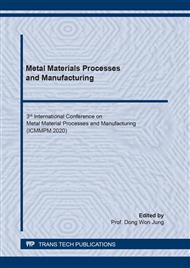p.111
p.117
p.123
p.131
p.137
p.147
p.153
p.163
p.169
Formability Analysis on Ultra-High Strength Steel for Automotive Parts Using Finite Element Simulation
Abstract:
Finite Element Method (FEM) is one of the most popular methods in the automotive industry to reduce problems, time and wastes in production processes. This method can predict the metal forming processes with computer modeling before making forming tools. In sheet metal forming analysis, Forming Limit Diagram (FLD) is one of the most important indicators in FEM, it can tell each forming regions such as cracks, wrinkles and safe zone. However, the FLD that has automatically created in finite element program isn’t enough accurate. Then, the main objective of this research work was to generate FLD of the ultra-high strength steel: NSC980D that usually has been used in auto body frame by using Nakajima's tests. Then, the generated FLD was used to simulate the forming of the automotive parts for solving the cracks caused during the forming along with the Hill’s 1948 material model. The Keeler’s FLD, which is generated automatically by the commercial software applied, was plotted for comparison during simulation, as well. Drawing process of the panel front was investigated by applying FEM simulating tool: PAMSTAMP to analyze the formability and to determine the optimal forming parameters under suitable service conditions. The main parameters of interest were the part and blank configuration. A number of corrections were successively made to successfully form the part. From the analysis of 2 case studies, it was found that tearing was occurred in the first case results. When the forming force was reduced from 15 tons to 9 tons in the second case, the complete forming without tearing and similar like actual forming at the same conditions had been taken place in the second results.
Info:
Periodical:
Pages:
137-144
Citation:
Online since:
January 2021
Authors:
Price:
Сopyright:
© 2021 Trans Tech Publications Ltd. All Rights Reserved
Share:
Citation:


